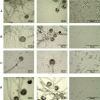Characterization of Aspergillus section Flavi associated with stored grains
- PMID: 38231446
- PMCID: PMC10834605
- DOI: 10.1007/s12550-023-00514-1
Characterization of Aspergillus section Flavi associated with stored grains
Abstract
Increased frequencies of Aspergillus section Flavi and aflatoxins in cereal grains have been seen in recent years due to changes in climate circumstances, such as high temperatures and drought. To assess the microbiological risks of contamination, it is critical to have a reliable and accurate means of identifying the fungi. The main goal of this study was to characterize Aspergillus species from section Flavi obtained from twenty-three samples of barley and maize grains, gathered from different markets in Qena, Egypt, using morphological and molecular techniques. Twenty-three isolates were chosen, one isolate from each sample; they were identified as A. aflatoxiformans (4 isolates), A. flavus (18), and A. parasiticus (1). The existence of four aflatoxin biosynthesis genes was also investigated in relation to the strains' ability to produce total aflatoxins and aflatoxin B1, focusing on the regulatory gene aflR and the structural genes aflD and aflM. All strains producing aflatoxins were linked to the presence of aflR1 and/or aflR2, except two isolates that exhibited aflatoxins but from which aflR1 or aflR2 were not detected, which may be due to one or more missing or unstudied additional genes involved in aflatoxin production. AflD and aflM genes were amplified by 10 and 9 isolates, respectively. Five samples of barley and maize were contaminated by aflatoxins. Fifteen isolates were positive for producing total aflatoxins in the range of 0.1-240 ppm. Antagonistic activity of Trichoderma viride against A. flavus (F5) was assessed at 31.3%. Trichoderma reduced total aflatoxins in all treated seeds, particularly those subjected to Trichoderma formulation.
Keywords: Aflatoxins; Calmodulin gene; Flavi; Trichoderma.
© 2023. The Author(s).
Conflict of interest statement
The authors declare no competing interests.
Figures





Similar articles
-
Aspergillus population diversity and its role in aflatoxin contamination of cashew nuts from coastal Kenya.PLoS One. 2024 Jan 25;19(1):e0292519. doi: 10.1371/journal.pone.0292519. eCollection 2024. PLoS One. 2024. PMID: 38271327 Free PMC article.
-
Characterization of Aspergilli from dried red chilies (Capsicum spp.): Insights into the etiology of aflatoxin contamination.Int J Food Microbiol. 2019 Jan 16;289:145-153. doi: 10.1016/j.ijfoodmicro.2018.08.025. Epub 2018 Aug 27. Int J Food Microbiol. 2019. PMID: 30243147
-
Phylogenetic studies and distinction of aflatoxin-producing Aspergillus species in section Flavi, Ochraceorosei and Nidulantes: A review.Gene. 2025 Feb 10;937:149151. doi: 10.1016/j.gene.2024.149151. Epub 2024 Dec 9. Gene. 2025. PMID: 39662646 Review.
-
Taxonomy of Aspergillus section Flavi and their production of aflatoxins, ochratoxins and other mycotoxins.Stud Mycol. 2019 Jun;93:1-63. doi: 10.1016/j.simyco.2018.06.001. Epub 2018 Jul 31. Stud Mycol. 2019. PMID: 30108412 Free PMC article.
-
Biodiversity of Aspergillus section Flavi in Europe in relation to the management of aflatoxin risk.Front Microbiol. 2014 Jul 21;5:377. doi: 10.3389/fmicb.2014.00377. eCollection 2014. Front Microbiol. 2014. PMID: 25101075 Free PMC article. Review.
Cited by
-
Multi-omics characterization of aflatoxigenic Aspergillus from grains and rhizosphere of maize across agroecological zones of Cameroon.Sci Rep. 2025 May 26;15(1):18407. doi: 10.1038/s41598-025-97296-6. Sci Rep. 2025. PMID: 40419733 Free PMC article.
References
-
- Abdel-Nasser A, Fathy HM, Badr A, Hathout A, Barakat OS. Prevalence of aflatoxigenic fungi in cereal grains and their related chemical metabolites. Egypt J Chem. 2022;65:1–2.
-
- Ben Fredj SM, Chebil S, Mlik A. Isolation and characterization of ochratoxin A and aflatoxin B1 producing fungi infecting grapevines cultivated in Tunisia. Afric J Microbiol Res. 2009;3:523–527.
MeSH terms
Substances
LinkOut - more resources
Full Text Sources
Miscellaneous

